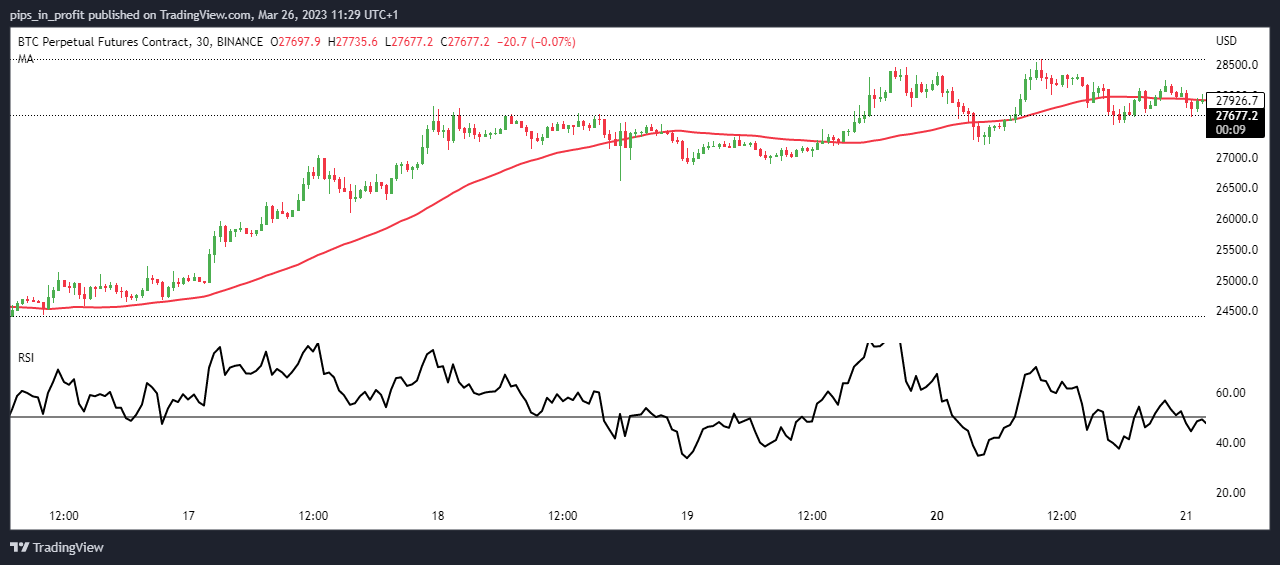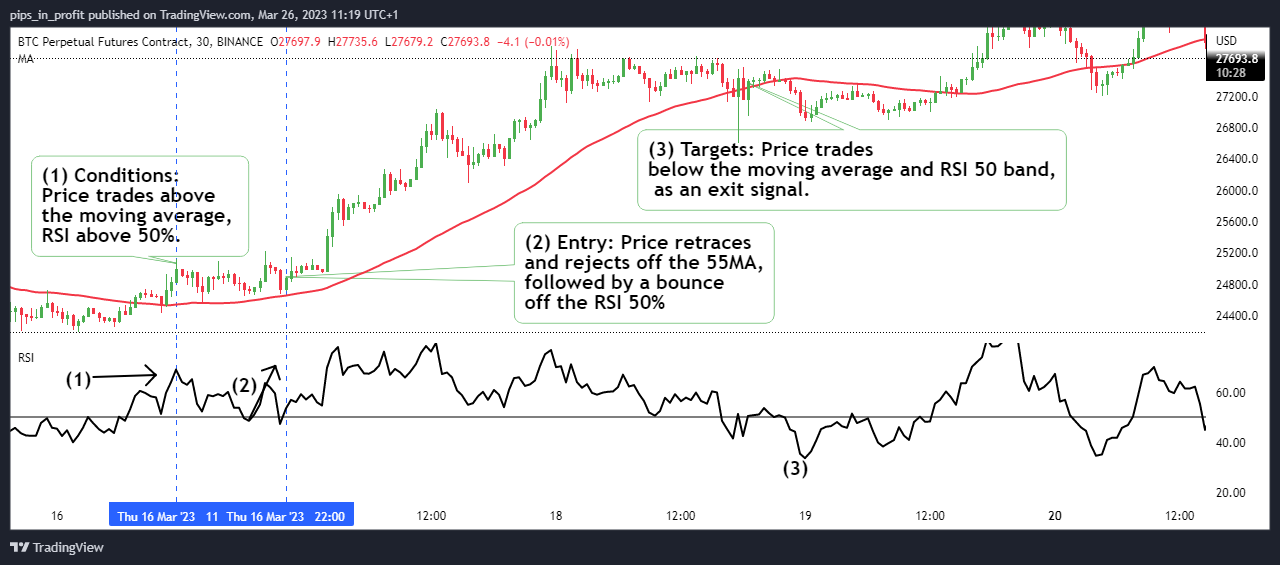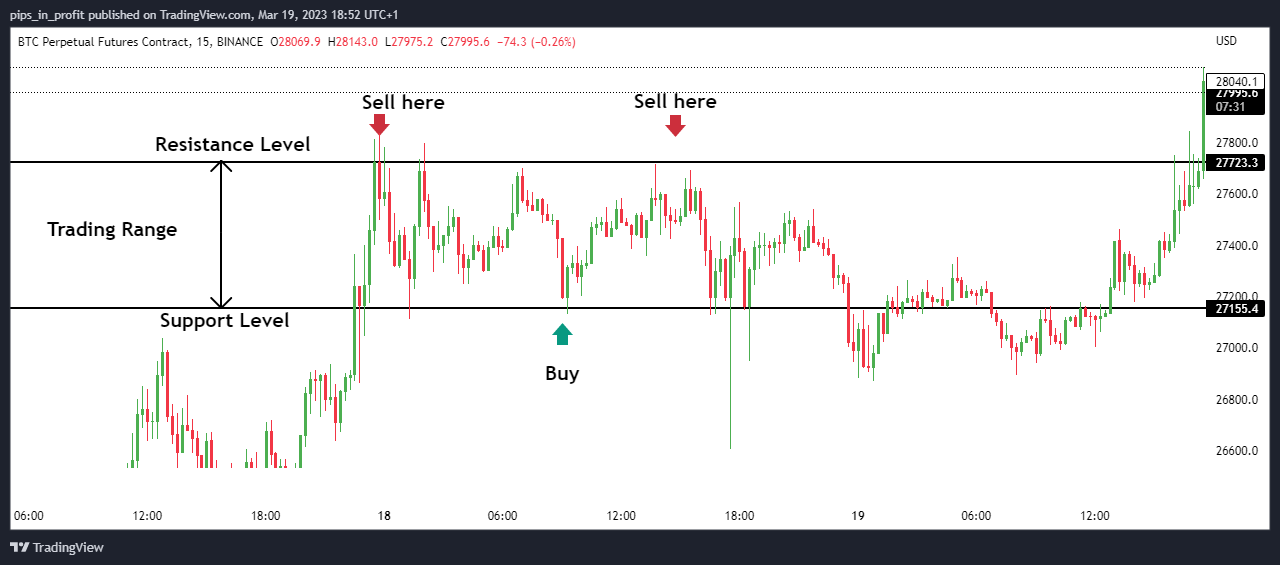How to Take Profits in Crypto Trading? Short-Term Trading Strategies

Cryptocurrency trading has become a popular investment option for many people looking to diversify their portfolios and earn significant returns. However, trading in the crypto market can be volatile and unpredictable, making it challenging to know when to buy or sell assets. Taking profit is an essential aspect of crypto trading that requires careful planning and strategy.
A solid trading strategy is vital to be profitable in crypto trading. Such a strategy can be developed using various methods, such as fundamental, technical, and emotional analyses. A comprehensive approach that combines these methods and includes proper risk management strategies can help maximize profits and minimize losses.
This article will discuss how to take profit in crypto trading, including when to buy and sell cryptocurrencies. You’ll learn to identify market entry and exit points and popular short-term trading strategies. We will also provide successful tips for trading crypto for short-term profit, maximizing your returns while minimizing risk.
Understanding the Crypto Market
If you're going to take profit in crypto trading, you need to understand the market you're dealing with. The crypto market is notoriously volatile and subject to frequent price swings, which can be intimidating for new traders. However, you can better position yourself for success by understanding market cycles, trends, and volatility.
Market Cycles and Trends
Like any other financial market, the crypto market operates in cycles influenced by sentiment, adoption rates, regulations, and technology. Analyzing historical price data reveals patterns to help you make informed trading decisions.
Take Bitcoin's market cycle, for instance. Every four years, a halving event occurs, reducing the reward Bitcoin miners receive for validating transactions. During the first two events in 2012 and 2016, Bitcoin's price skyrocketed from $12 to over $1,000 and $600 to nearly $20,000, respectively.
While these patterns suggest a correlation between halving events and price increases, they don't guarantee future results. Other global economic factors may influence cryptocurrency prices. Still, keeping track of market cycles and trends lets you stay ahead of the game and make informed investment decisions.
Bull and Bear Markets
Another critical concept to understand is bull and bear markets. A bull market is when asset prices rise, while falling asset prices characterize a bear market. These terms are often used to describe the overall market sentiment, and they can impact your trading decisions. It's essential to remember various factors, including global events, news, and social media, can influence bull and bear markets.
Market Volatility
Market volatility is a reality in the crypto market. Prices can rise and fall rapidly, making it challenging to predict future price movements accurately. For example, when Elon Musk tweets about cryptocurrencies, the market often reacts, causing prices to fluctuate wildly.
Furthermore, it's common for cryptocurrencies to experience price swings of 10% or more in a single day. For example, on March 12, 2020, Bitcoin fell over 50% in a single day due to the COVID-19 pandemic, resulting in economic uncertainty.
The largest swing in the price and percentage of Bitcoin occurred on December 17, 2017, with an all-time high of $19,783.06. This was a gain of approximately 1,900% from its price at the beginning of that year.
Pump and dump schemes are another reason for rapid volatility in crypto. In 2017, Verge experienced a sudden price surge, making it one of the top 10 cryptocurrencies by market capitalization. This surge resulted from a coordinated pump-and-dump scheme that saw a group of investors spreading false information to inflate the price.
Unfortunately, the scheme was short-lived, and the price quickly plummeted to its pre-surge levels, leaving investors with significant losses. Investors should be cautious of sudden price movements resulting from market manipulation and conduct thorough research before investing in any cryptocurrency.
Key Points About Taking Profits In Crypto
Once you understand the cryptocurrency market, you must learn how to analyze it to make the right trading decision. Identifying the right market entry and exit points is crucial to maximizing profit and mitigating losses. Here are some major approaches to analyzing the crypto market and taking profit.
Technical Analysis
Technical analysis involves using past price data and chart patterns to identify potential entry points. Traders who use technical analysis will often look for indicators like moving averages, support and resistance levels, and trading volume to identify potential buying opportunities.
Fundamental Analysis
Fundamental analysis involves analyzing the underlying factors that drive the value of a cryptocurrency. Traders who use fundamental analysis will often look at factors like adoption rates, market capitalization, regulatory changes, and technological advancements to identify potential buying opportunities.
Sentimental Analysis
The sentimental analysis involves considering market sentiment and the emotions of other traders to identify potential entry points.
Find the best time to entry and exit
When it comes to crypto trading, timing is everything. Finding the best time to enter and exit a trade can greatly impact your profitability. To begin with, you should analyze the market trends and patterns. Look for key support and resistance levels, and monitor any news or events that may affect the cryptocurrency's price. Next, consider using technical analysis tools and chart patterns to identify potential entry and exit points. By combining these strategies, you can increase your chances of finding the best time to enter and exit in crypto trading.
How to Trade Crypto Using Technical Analysis
There are many technical trading strategies for short-term crypto trading. One simple but effective strategy combines moving average and RSI indicators.
First, you want to set the period for your moving average to 55. Furthermore, you want to remove the RSI's upper and lower band, leaving only the mid (50) band. Once you're done, your chart should look something like this:

Image: chart setup for the RSI+MA trend continuation strategy, source; tradingview.com
Here’s how to trade crypto using this technical strategy in five steps:
Step 1. Conditions: In an uptrend, you want the price to be above the 55ma and 50 band of the RSI simultaneously. With these conditions met you can consider placing a long entry. Conversely, to consider short entries, the price has to be below the 55ma and mid-band of the RSI in a downtrend.
Step 2. Entries: Once you have identified the conditions, you want to see the price move away from the 55ma and wait for a subsequent retracement to the moving average. At the same time, the RSI should also move towards the mid-band. For an entry signal, you want to see a rejection off the moving average and a bounce off the RSI 50 bands.

image: an example of a bullish trade using the rsi+ma trend continuation strategy, source: tradingview.com
Step 3. Stops: Initially, you want to place your stop loss above or below the moving average, depending on your directional bias. This could be a high or low in the market or a price where you are unwilling to lose further.
Step 4. Target: Determine a price level where you want to profit from the market when your analysis is correct. You can take partial profit as the price keeps going in your favour. Alternatively, you can set an order to close your position in profit when the price gets to a certain level. You can also wait till the price breaks the moving average and starts trading in the opposite direction.
Step.5 Monitor the trade: Once you have entered the trade, monitor the market closely to ensure it moves in your favor. Adjust your stop loss and profit target accordingly if necessary.
How to Trade Crypto Using Fundamental Analysis
For short-term trading with fundamental analysis, you want to focus on news and events that affect the cryptocurrency's value in the near term. In contrast, long-term investors may focus on the underlying trends and developments likely to drive the cryptocurrency's value over time.
Here’s how to trade crypto using fundamental analysis in five steps:
Step 1. Analyze the underlying factors that drive the value of the cryptocurrency: The value of a cryptocurrency is driven by several factors, including:
Adoption rates: How widely cryptocurrency is being used in commerce and trade.
Technology developments: Advances in the underlying technology that improves the cryptocurrency's functionality, security, and efficiency.
Market sentiment: The overall mood of the market towards cryptocurrency, which is influenced by news events, investor sentiment, and regulatory changes.
Competition: Other cryptocurrencies that offer similar functionality or benefits, which can impact the value of the cryptocurrency.
For example, Bitcoin's value is driven by its limited supply and increasing adoption rates, while Ethereum's value is driven by its widespread use in decentralized finance (DeFi) applications.
Step 2. Look for a buying opportunity: Once you have identified the factors driving the cryptocurrency's value, look for a buying opportunity. This may be a dip in the price caused by temporary market conditions or negative news events. Look for opportunities to buy the cryptocurrency at a discount to its underlying value.
For example, if a regulatory crackdown lowers the price of a cryptocurrency, it may be a buying chance if the technology and adoption rates are strong.
Step 3. Set a stop-loss order: To protect against significant losses, set a stop-loss order at a level that represents an acceptable level of risk. This will automatically close your position if the cryptocurrency's value declines unexpectedly.
Step 4. Look for signs of a peak or decline: Keep an eye on the factors driving the cryptocurrency's value and look for signs that the value may be peaking or declining. For example, if competition is increasing or adoption rates are slowing down, it may be a sign that the value of the cryptocurrency is likely to decline.
Step 5. Adjust your position accordingly: Keep monitoring the market and adjust your position as necessary. Change your position or sell it if conditions change or you think it's a bad plan.
Remember, fundamental analysis is just one tool in your trading toolkit. It's important to also consider technical analysis, market trends, and risk management when making trading decisions.
How to Trade Crypto Using Sentimental Analysis
The sentimental analysis involves considering market sentiment and the emotions of other traders to identify potential entry points. Traders who adopt this style of analysis will often look at social media trends, news, and other factors to determine when the market is experiencing fear or greed.
A real-life example of using sentimental analysis is during the market crash of March 2020. The COVID-19 pandemic caused panic, so the crypto market experienced a significant price drop. Traders who brought in during the crash and held onto their investments made substantial profits when the market recovered.
A very small percentage of traders adopt the sentimental approach to trading because it is considered subjective and difficult to quantify. The sentimental analysis involves analyzing market sentiment, which refers to the overall attitude of traders toward a particular asset or market. This approach focuses on news, social media trends, and investor sentiment.
However, since this analysis is based on human emotions and perceptions, it can be highly subjective and open to interpretation. Additionally, the sentiment can quickly change, making it challenging to create a long-term strategy. As a result, most traders prefer to use more objective methods, such as technical and fundamental analysis, to make trading decisions.
Emotional Management in Crypto Trading
Emotional management is crucial for successful crypto trading. Emotions such as fear, greed, and FOMO (fear of missing out) can lead to impulsive and irrational trading decisions, ultimately resulting in losses. Here are some useful tips for managing emotions in crypto trading:
Develop a trading plan: A well-defined trading plan can help you avoid impulsive decisions driven by emotions. Your plan should include clear entry and exit points, risk management strategies, and a target profit.
Stick to your plan: Once you have a plan, it's essential to stick to it. Avoid deviating from your plan based on emotions like fear, greed, or FOMO.
Use stop-loss orders: Setting stop-loss orders can help you limit your losses if a trade goes against you. This technique can also help you avoid making impulsive decisions based on emotions.
Take breaks: Crypto trading can be stressful, and taking breaks is essential to avoid becoming overwhelmed by emotions. Take some time off regularly to recharge and clear your mind.
Manage your risk: Crypto trading can be risky, and managing your risk correctly is crucial. Only invest what you can afford to lose, and avoid putting all your eggs in one basket.
How to Find the best time to enter and exit
It's important to note that there is no best time to enter and exit the crypto market. Traders must have a trading strategy to navigate the market and predict the best times to enter and exit. In addition to using the strategies discussed above, traders should adopt proper risk management and manage their emotions.
This means setting clear profit targets and stop-loss orders, diversifying portfolios, and avoiding emotional trading decisions. It's also important to remember that market conditions can change quickly, so traders should remain flexible and be prepared to adjust their strategies as needed.
Popular Cryptocurrency Short-Term Trading Strategies
Short-term trading in the cryptocurrency market requires a different set of strategies compared to long-term investing. It's important to note that each strategy comes with risks and rewards, and traders must carefully consider their goals and risk tolerance before adopting any strategy. Proper risk management and emotional control are crucial to avoid making impulsive decisions that could lead to losses.
Here are the most popular strategies that traders use to profit from short-term price movements in the crypto market:
1. High-Frequency Trading (HFT) Strategies
This strategy uses advanced algorithms to analyze market data and execute trades quickly. HFT traders aim to profit from small price fluctuations within seconds or milliseconds.
How to trade crypto using HTF:
To use this strategy, traders need access to high-speed trading platforms and low-latency connections to the market. The trader can profit from arbitrage options and bid and ask spread difference. It is important to note that this strategy is not beginner-friendly as it’s highly risky and can cost money to set up.
2. Day Trading Strategies
Day trading involves buying and selling cryptocurrencies within a single trading day. Day traders aim to profit from small price movements within a day. For this strategy, traders must closely monitor market news and events and use technical analysis to identify entry and exit points.
How to trade using Day trading strategies:
Range Trading: Range trading is a day trading strategy that involves identifying key support and resistance levels and buying low and selling high within that range. This strategy is particularly effective in a sideways market where prices are not moving in any particular direction.

Image: an example of range-bound trading, source: tradingview.com
Moving average trading: This strategy employs the moving average indicator, a dynamic line plotted with the average closing price of the crypto over a specified session. You look for buying opportunities when the price trades above the MA. Conversely, look for selling opportunities when the price trades below.
For example, you can buy off a rejection from the MA when the price is above. On the other hand, you can sell off a rejection when the price trades below.
Rsi Trading: The RSI is a momentum indicator that estimates the strength of the price at any given time. The market can be considered overbought when the price is upward and the RSI is above 70%. Conversely, when trading downwards below 30%, the asset can be deemed oversold. This implies that you can look for selling opportunities when the price is overbought and buying opportunities when the price is oversold.
For example, when the price trades in an overbought condition, you can decide to sell off a resistance level. Alternatively, you can buy off a support level when the price trades in an oversold condition.
3. News-Based Trading Strategy
News trading involves using market news and events to make trading decisions. Traders use this strategy to capitalize on sudden price movements that occur as a result of news announcements. For this strategy, traders must stay updated with market news and events and act quickly to enter and exit trades.
How to trade News releases:
Stay up to date with relevant news and events.
Analyze the potential impact on your cryptocurrency.
Determine your entry and exit points based on your trading strategy.
Take a trade prior to the news release following your directional bias.
Use proper risk management techniques, such as setting stop-loss orders.
Successful Tips for Trading Crypto for Short-Term Profit
If you want to profit from crypto trading, you need a solid trading strategy. Trading cryptocurrencies for short-term profit can be lucrative but requires a disciplined approach.
Here are some successful tips to help you trade crypto for short-term gain:
Take small percentages of your profits in 30% increments to maximize price increases while minimizing risk.
Limit your risk to 2% of your total trading capital per trade and use stop-loss orders to protect your profits and minimize losses.
Identify and stick to your profit target before entering a trade to avoid emotional trading and significant losses.
Keep your profits in fiat reserve-backed stablecoins to avoid the volatility of the crypto market.
Stay up-to-date with news and events, such as regulatory changes and technological advancements, to make informed trading decisions. For example, when China announced a crackdown on cryptocurrency mining in 2021, the market reacted, and prices fell.

* The content presented above, whether from a third party or not, is considered as general advice only. This article should not be construed as containing investment advice, investment recommendations, an offer of or solicitation for any transactions in financial instruments.


